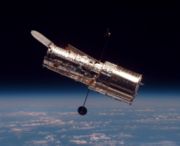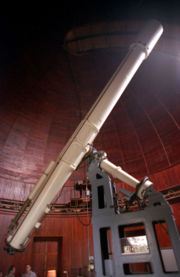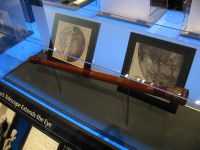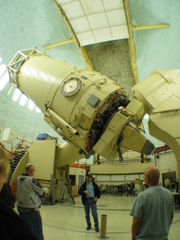Telescope
2007 Schools Wikipedia Selection. Related subjects: Engineering
A telescope (from the Greek tele = 'far' and skopein = 'to look or see'; teleskopos = 'far-seeing') is an instrument designed for the observation of remote objects. The term usually refers to optical telescopes, but there are telescopes for most of the spectrum of electromagnetic radiation and for other signal types.
An optical telescope gathers and focuses visible light and other electromagnetic radiation. Telescopes increase the apparent angular size of distant objects, as well as their apparent brightness. Telescopes work by employing one or more curved optical elements - lenses or mirrors - to gather light or other electromagnetic radiation and bring that light or radiation to a focus, where the image can be observed, photographed or studied. Optical telescopes are used for astronomy and in many non-astronomical instruments including theodolites, transits, spotting scopes, monoculars, binoculars, camera lenses and spyglasses.
Single-dish Radio telescopes are focusing radio antennae often having a parabolic shape. The dishes are sometimes constructed of a conductive wire mesh whose openings are smaller than a wavelength. Multi-element Radio telescopes are constructed from pairs or larger groups of these dishes to synthesize large "virtual" apertures that are similar in size to the separation between the telescopes: see aperture synthesis. As of 2005, the current record array size is many times the width of the Earth, utilizing space-based Very Long Baseline Interferometry (VLBI) telescopes such as the Japanese HALCA (Highly Advanced Laboratory for Communications and Astronomy) VSOP (VLBI Space Observatory Program) satellite. Aperture synthesis is now also being applied to optical telescopes using optical interferometers (arrays of optical telescopes) and Aperture Masking Interferometry at single telescopes.
X-ray and gamma-ray telescopes have a problem because these rays go through most metals and glasses. They use ring-shaped "glancing" mirrors, made of heavy metals, that reflect the rays just a few degrees. The mirrors are usually a section of a rotated parabola. High energy particle telescopes detect a flux of particles, usually originating at an astronomical source.
History
The first telescopes may have been Assyrian crystal lenses , but the Visby lenses tentatively suggest that the technology was known to the Arabs and Persians. Leonard Digges is sometimes credited with the invention in England in the 1570s, but usually credit for assembling the first telescope is given to an unknown Dutch spectacle maker in about 1608. Some name that person as Hans Lippershey (c. 1570 – c. 1619), but Jacob Metius and Zacharias Jansen also claimed to have invented a telescope during the same period. Even if Lippershey did not make the first one, he publicized it. Galileo Galilei made his own telescope in 1609, calling it at first a "perspicillum," and then using the terms "telescopium" in Latin and "telescopio" in Italian (from which the English word derives). Galileo is generally credited with being the first to use a telescope for astronomical purposes. Galileo's telescope consisted of a convex object lens and a concave eye lens, which is universally called a Galilean telescope (used as a viewfinder in many simple cameras). Later, Johannes Kepler described the optics of lenses (see his books Astronomiae Pars Optica and Dioptrice), including a new kind of astronomical telescope with two convex lenses (a principle often called the Kepler telescope). Optical interferometer arrays and arrays of radio telescopes were developed much more recently.
Types of telescope
Telescopes are frequently characterised by their design details, and usually named after the principal designer or designers of that type of telescope. For optical telescopes, especially optical astronomical telescopes, there are three main types:
- The refracting telescope which uses solely an arrangement of lenses.
- The reflecting telescope which uses solely an arrangement of mirrors.
- The catadioptric telescope which uses a combination of mirrors and lenses.
Where the telescope is used for direct viewing by the human eye, then very few telescopes are pure reflectors, as it is usual to use an eyepiece to view the image, and most, if not all eyepiece design use an arrangement of lenses. Much astronomy is performed using photographic film or digital sensors which are usually used without an eyepiece, so for mechanised operation more telescopes are used as pure reflectors.
For more details see List of telescope types
Research telescopes
Most large research telescopes can operate as either a Cassegrain telescope (longer focal length, and a narrower field with higher magnification) or a Newtonian telescope (brighter field). They have a pierced primary mirror, a Newtonian focus, and a spider to mount a variety of replaceable secondary mirrors.
A new era of telescope making was inaugurated by the Multiple Mirror Telescope (MMT), with a mirror composed of six segments synthesizing a mirror of 4.5 meters diameter. This has now been replaced by a single 6.5m mirror. Its example was followed by the Keck telescopes with 10 m segmented mirrors.
The largest current ground-based telescopes have a primary mirror of between 6 and 11 meters in diameter. In this generation of telescopes, the mirror is usually very thin, and is kept in an optimal shape by an array of actuators (see active optics). This technology has driven new designs for future telescopes with diameters of 30, 50 and even 100 meters.
Relatively cheap, mass-produced ~2 meter telescopes have recently been developed and have made a significant impact on astronomy research. These allow many astronomical targets to be monitored continuously, and for large areas of sky to be surveyed. Many are robotic telescopes, computer controlled over the internet (see e.g. the Liverpool Telescope and the Faulkes Telescope North and South), allowing automated follow-up of astronomical events.
Initially the detector used in telescopes was the human eye. Later, the sensitized photographic plate took its place, and the spectrograph was introduced, allowing the gathering of spectral information. After the photographic plate, successive generations of electronic detectors, such as the charge-coupled device (CCDs), have been perfected, each with more sensitivity and resolution, and often with a wider wavelength coverage.
Current research telescopes have several instruments to choose from such as:
- imagers, of different spectral responses
- spectrographs, useful in different regions of the spectrum
- polarimeters, that detect light polarization.
In recent years, some technologies to overcome the distortions caused by atmosphere on ground-based telescopes were developed, with good results. See adaptive optics, speckle imaging and optical interferometry.
The phenomenon of optical diffraction sets a limit to the resolution and image quality that a telescope can achieve, which is the effective area of the Airy disc, which limits how close two such discs can be placed. This absolute limit is called the diffraction limit (or sometimes the Rayleigh criterion, Dawes limit or Sparrow's resolution limit). This limit depends on the wavelength of the studied light (so that the limit for red light comes much earlier than the limit for blue light) and on the diameter of the telescope mirror. This means that a telescope with a certain mirror diameter can resolve up to a certain limit at a certain wavelength. If greater resolution is needed at that wavelength, a wider mirror has to be built or aperture synthesis performed using an array of nearby telescopes.
Imperfect images
No telescope can form a perfect image. Even if a reflecting telescope could have a perfect mirror, or a refracting telescope could have a perfect lens, the effects of aperture diffraction could still not be escaped. In reality, perfect mirrors and perfect lenses do not exist, so image aberrations in addition to aperture diffraction must be taken into account. Image aberrations can be broken down into two main classes, monochromatic, and polychromatic. In 1857, Philipp Ludwig von Seidel (1821-1896) decomposed the first order monochromatic aberrations into five constituent aberrations. They are now commonly referred to as the five Seidel Aberrations.
The five Seidel aberrations
- Spherical aberration
- The difference in focal length between paraxial rays and marginal rays, proportional to the square of the aperture.
- Coma
- A most objectionable defect by which points are imaged as comet-like asymmetrical patches of light with tails, which makes measurement very imprecise. Its magnitude is usually deduced from the optical sine theorem.
- Astigmatism
- The image of a point forms focal lines at the sagittal and tangiental foci and in between (in the absence of coma) an elliptical shape.
- Curvature of Field
- The Petzval curvature means that the image instead of lying in a plane actually lies on a curved surface which is described as hollow or round. This causes problems when a flat imaging device is used e.g. a photographic plate or CCD image sensor.
- Distortion
- Either barrel or pincushion, a radial distortion which must be corrected for if multiple images are to be combined (similar to stitching multiple photos into a panoramic photo).
They are always listed in the above order since this expresses their interdependence as first order aberrations via moves of the exit/entrance pupils. The first Seidel aberration, Spherical Aberration, is independent of the position of the exit pupil (as it is the same for axial and extra-axial pencils). The second, coma, changes as a function of pupil distance and spherical aberration, hence the well-known result that it is impossible to correct the coma in a lens free of spherical aberration by simply moving the pupil. Similar dependencies affect the remaining aberrations in the list.
The chromatic aberrations
- Longitudinal Chromatic Aberration
- As with spherical aberration this is the same for axial and oblique pencils.
- Transverse Chromatic Aberration (Chromatic Aberration of Magnification)
Famous optical telescopes

- The Hubble Space Telescope is in orbit beyond Earth's atmosphere to allow for observations not distorted by astronomical seeing. In this way the images can be diffraction limited, and used for coverage in the ultraviolet (UV) and infrared.
- The Keck telescopes are currently ( as of 2005) the largest, but will soon be superseded by the Gran Telescopio Canarias and Southern African Large Telescope.
- The Very Large Telescope array (VLT) is currently ( as of 2002) the record holder for total collecting area in an array of telescopes, with four telescopes each 8 meters in diameter. The four telescopes, belonging to the European Southern Observatory (ESO) and located in the Atacama desert in Chile, are usually operated independently for faint astronomical observations, but up to three telescopes can be operated together for aperture synthesis observations of bright objects.
- The Navy Prototype Optical Interferometer is the optical telescope (array) that can currently ( as of 2005) produce the highest resolution images at visible wavelengths.
- The CHARA (Centre for High Angular Resolution Astronomy) array is the telescope array that can currently ( as of 2005) produce the highest resolution images at near-infrared wavelengths.
- There are many plans for even larger telescopes. One of them is the Overwhelmingly Large Telescope (OWL), which is intended to have a single aperture of 100 meters in diameter.
- The 200-inch (5.08-meter) Hale telescope on Palomar Mountain was the largest conventional research telescope for many years. It has a single borosilicate ( Pyrex™) mirror that was famously difficult to construct. The mounting is a special design of equatorial mount called a yoke mount, which permits the telescope to be pointed at and near the north celestial pole.
- The 100-inch (2.54-meter) Hooker Telescope at the Mount Wilson Observatory was used by Edwin Hubble to discover galaxies and the redshift. The mirror was made of green glass by Saint-Gobain. In 1919, the telescope was used for the first stellar diameter measurements using interferometry. The telescope now has an adaptive optics system, and is still useful for advanced research.
- The 72-inch Leviathan at Birr Castle (in Ireland) was the largest telescope in the world from 1845 until it was dismanlted in 1908. It was not exceeded in size until the construction of the Hooker Telescope.
- The 1.02-meter Yerkes Telescope (in Wisconsin) is the largest aimable refracting telescope in use.
- The 0.76-meter Nice refractor (in France) that became operational in 1888 was at that time the world's largest refractor. This was the last time the most powerful operational telescope in the world was located in Europe. It was exceeded in size one year later by the 0.91-meter refractor at the Lick Observatory.
- The largest refractor ever constructed was French. It was on display at the 1900 Paris Exposition. Its lens was stationary, prefigured so as to sag into the correct shape. The telescope was aimed by the aid of a Foucault sidérostat, which is a movable plane mirror with a 2-meter diameter, mounted in a large cast-iron frame. The horizontal tube was 60 m long and the objective had 1.25 m in diameter. It was a failure.
- The Gran Telescopio CANARIAS ( Grantecan, also GTC), is a high performance segmented 10.4 meter telescope that is being installed in one of the best sites of the Northern Hemisphere: the Roque de los Muchachos Observatory (La Palma, Canary Islands, Spain).
- The 1-meter refracting Swedish Solar Telescope (SST) on La Palma (Spain), is currently the highest-resolution solar telescope in the world.
Other famous telescopes
- Arecibo Observatory
- Atacama Large Millimeter Array
- Very Large Array
- Chandra X-ray Observatory
- XMM-Newton
- LIGO
- IceCube Neutrino Detector
- Isaac Newton Telescope
- William Herschel Telescope
- Hexapod-Telescope



